Tom's Hardware Verdict
MSI packs in a lot of performance into a high-quality and relatively lightweight chassis with the Sword 15.
Pros
- +
Solid, subdued design
- +
Good overall gaming performance
- +
Wide variety of ports
Cons
- -
Mediocre webcam
- -
Poor audio
- -
Fans are loud under load
Why you can trust Tom's Hardware
The MSI Sword 15 is an intriguing gaming laptop that's priced competitively. While many gaming laptops are in your face with tons of RGB and flashy designs, MSI plays it safe with a simple white and black color scheme, coupled with cool blue backlighting for the keyboard.
The 15.6-inch chassis weighs a hair under five pounds, and it should easily slip into a laptop bag when traveling.
Our test configuration includes an Intel Core i7-12650H processor and an Nvidia GeForce RTX 3060 discrete GPU. Priced at $1,349.99, the Sword 15 is in contention to be one of the best gaming laptops under $1,500.
Design of the MSI Sword 15
The MSI Sword 15 is a beefy laptop with an attractive design. The lid and keyboard deck are made of white plastic with a shimmering, pearlescent finish. The Sword 15 flies under the radar, and even the MSI logo embossed on the lid blends in, as it is devoid of color. There’s an interesting mix of finishes as well. While the top of the lid and keyboard deck are smooth, the sides feature a brushed finish.
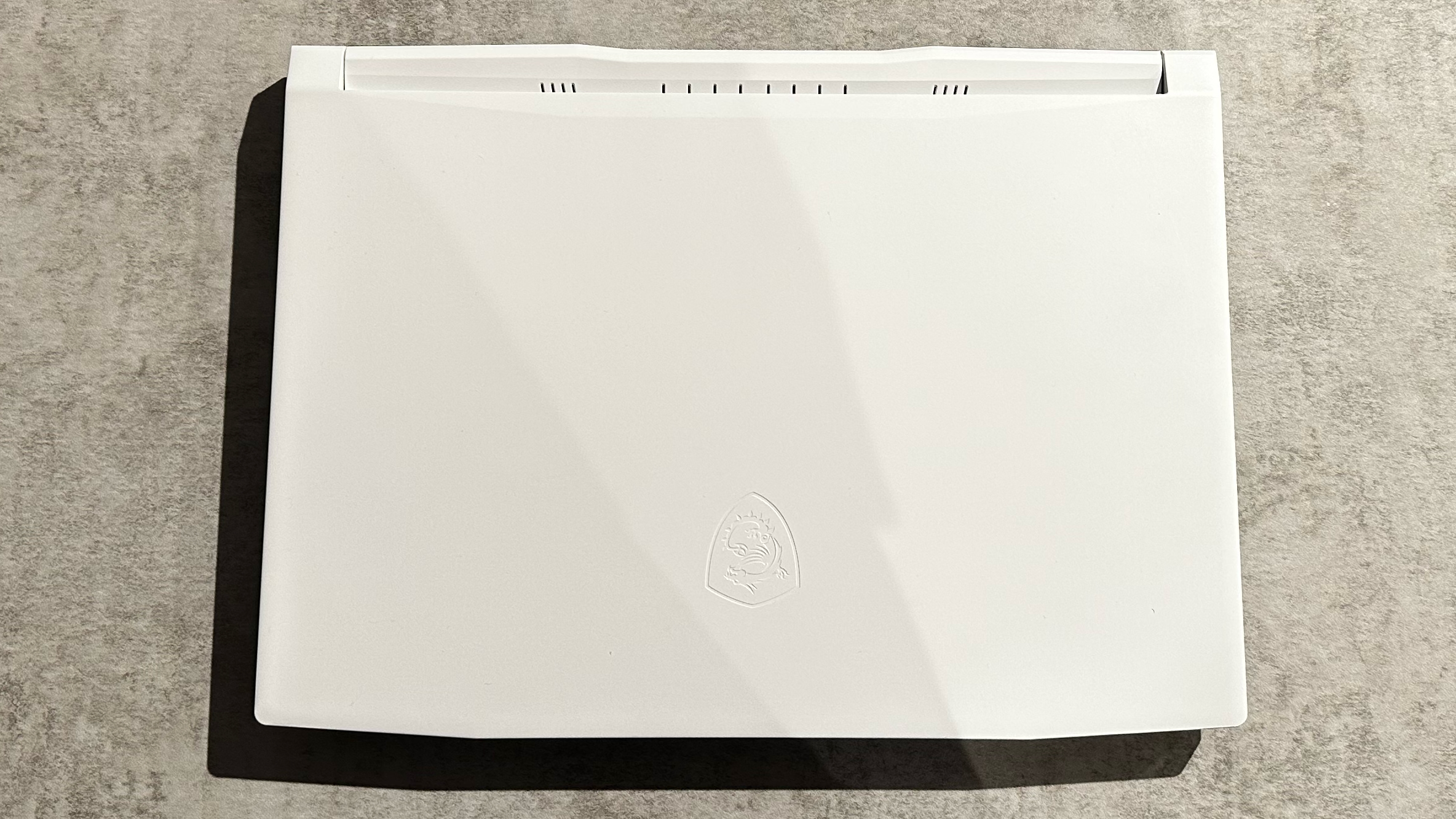
Flipping up the lid reveals the keyboard, with white keycaps backlit with blue LEDs. Black plastic trims the display and makes up the chassis's bottom half. A 720p webcam is situated above the 15.6-inch (16:9) 144 Hz IPS display. The display features a matte finish, and the bezels are minimal along the right and left. However, the top bezel is a bit on the thick side, while the bottom bezel – which houses the MSI logo – is also on the chunky side.
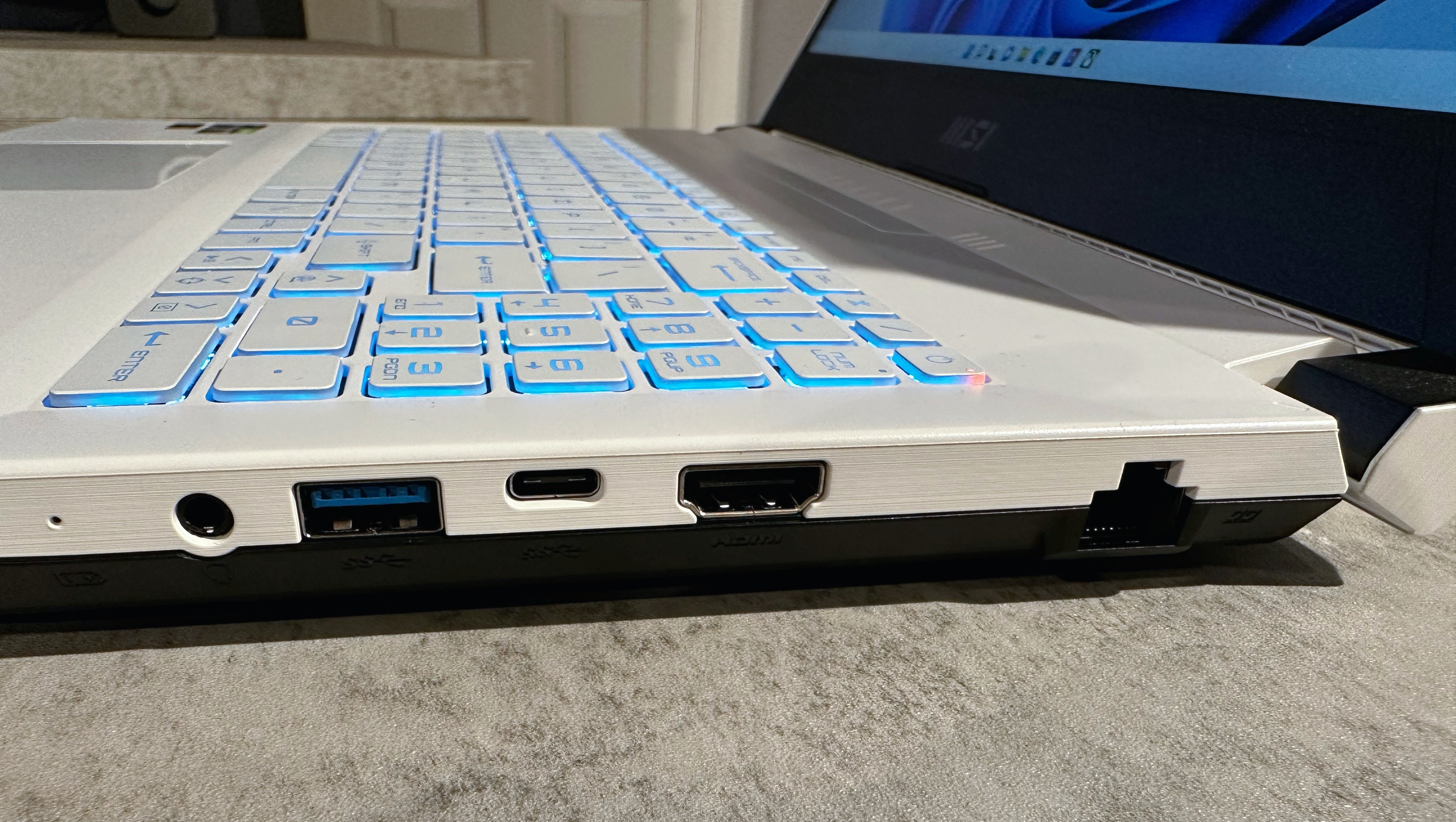
The Sword's ports are quite plentiful. On the right side, you’ll find a 3.5 mm headphone jack, one USB 3.2 Type-A port, one USB-C 3.1 Type-C, HDMI 2.1 and Ethernet. The left side is home to one USB 3.2 Type-A port, One USB 2.0 Type-A port and the proprietary input for the 240-watt power brick.
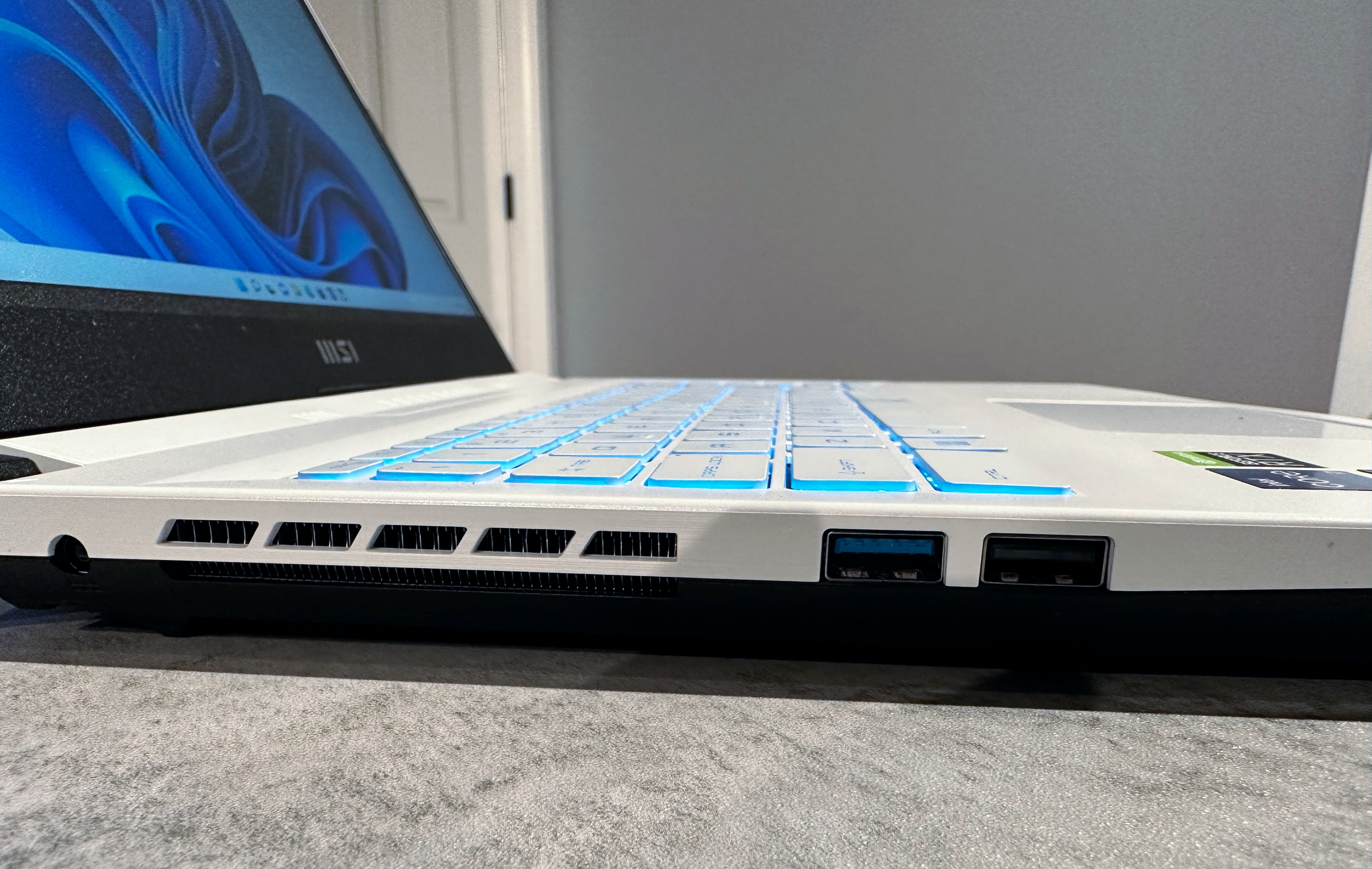
MSI offers plenty of cooling for the Sword 15; there’s a thin strip of vents on the left side between the power and USB ports, and two exhaust vents on the rear of the chassis. Flipping the laptop over, you’ll notice several vents in a honeycomb pattern (which also allows you to peek at the maze of copper heat pipes).
Get Tom's Hardware's best news and in-depth reviews, straight to your inbox.

The Sword 15 weighs 4.96 pounds, which is reasonable for a 15-inch gaming notebook, and over a half-pound lighter than the Acer Nitro 5. Still, it’s about half a pound heavier than the Asus TUF Gaming F15. The MSI is 0.98 inches thick, again landing in between the Nitro 5 (1.06 inches) and the TUF Gaming F15 (0.78 inches).
| CPU | Intel Core i7-12650H |
| Graphics | Nvidia GeForce RTX 3060 (6GB GDDR6, 1525 MHz Boost Clock, 105 W Max Graphics Power) |
| Memory | 16GB DDR4-3200 |
| Storage | 1TB PCIe NVMe M.2 SSD |
| Display | 15.6-inch, 1920x1080, 144 Hz, 16:9 |
| Networking | Intel AX201 Wi-Fi 6, Bluetooth 5.2 |
| Ports | 1x USB 3.2 Type-C Gen 1, 2x USB 3.2 Type-A Gen 1, 1x USB 2.0 HDMI 2.1, 3.5mm headphone jack, Ethernet |
| Camera | 720p |
| Battery | 53 Whr |
| Power Adapter | 240 W |
| Operating System | Windows 11 Home |
| Dimensions (WxDxH) | 14.13 x 10.20 x 0.98 inches (358.9 x 258 x 24.89 mm) |
| Weight | 4.96 pounds (2.23 kg) |
| Price (as configured) | $1,349.99 |
Gaming and Graphics on the MSI Sword 15
Our review configuration of the Sword 15 is powered by an Intel Core i7-12650H processor and an Nvidia GeForce RTX 3060 GPU. That puts it a step ahead of competitors like the Acer Nitro 5 (Core i5-12500H, RTX 3050), and you still have enough muscle to play most games at 1080p resolution with the goodies turned on.
I fired up Control (High, 1080p) and jumped right into the action with generally smooth frame rates, although I saw performance dip just below 50 frames per second during combat. Dropping to 720p and flipping on DLSS saw performance stabilize around the 70 fps (frames per second) mark during the same gaming conditions.
Regarding benchmarking in Shadow of the Tomb Raider, the Sword 15 was able to outpace both the Acer Nitro 5 and the Alienware x14 R1 (Core i7-12700H, RTX 3060) with a result of 70 fps, but came up just a few frames per second behind the Asus TUF Gaming F15. It should be noted that the TUF Gaming F15 also sneaks an RTX 3060 under the hood, albeit with a slightly more powerful Core i7-12700H processor.
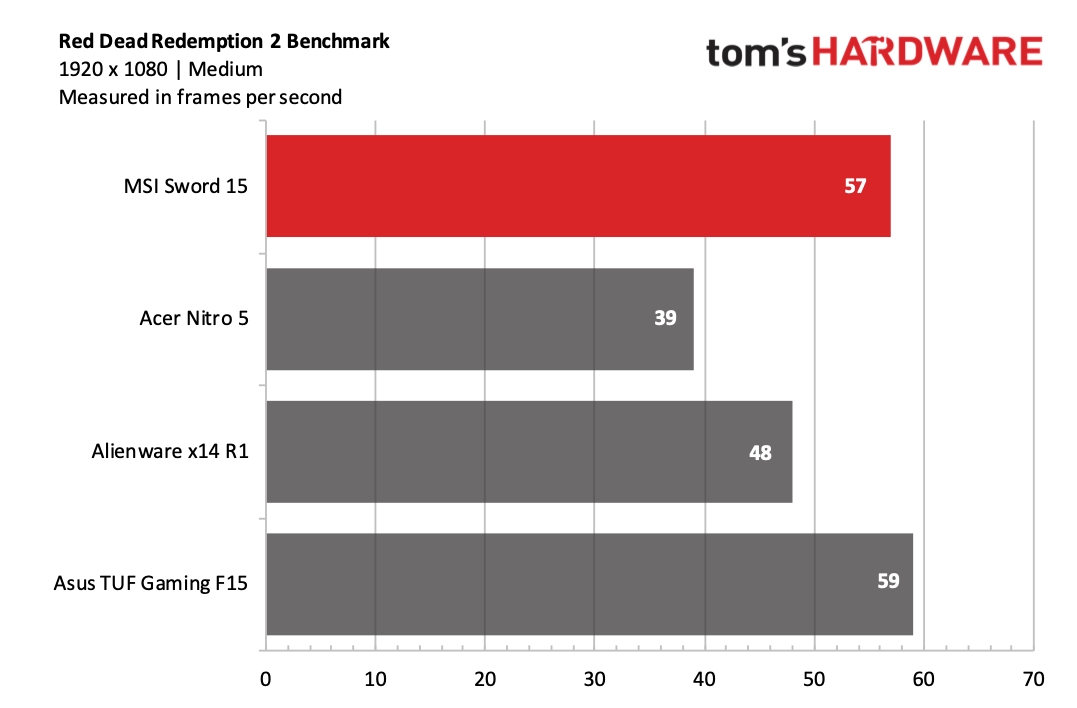
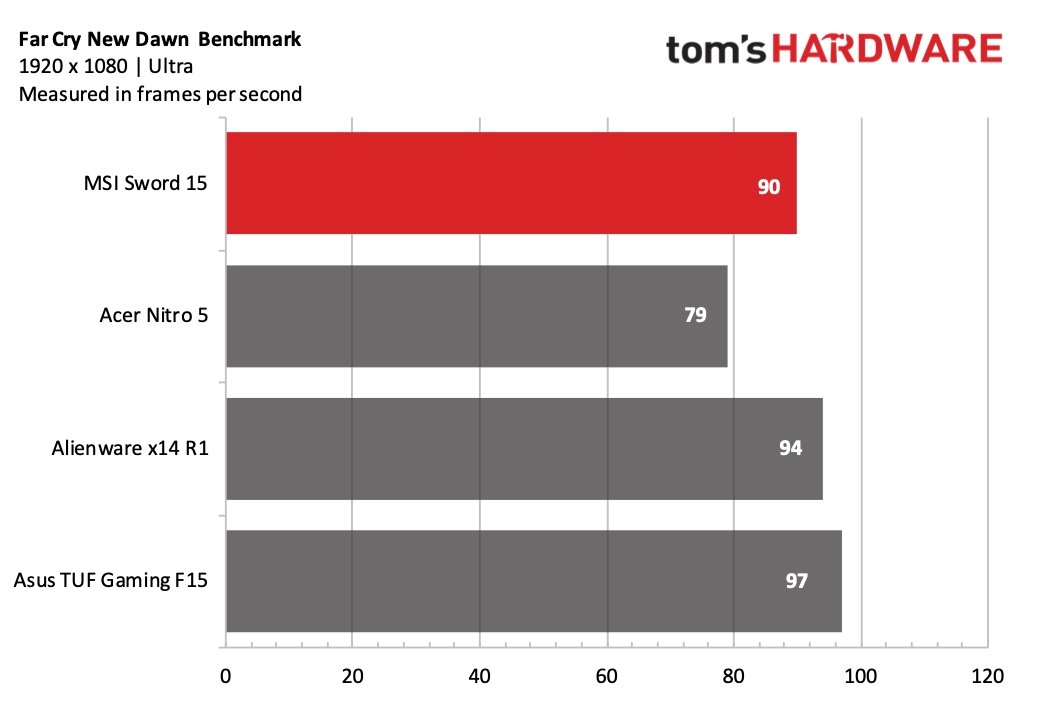


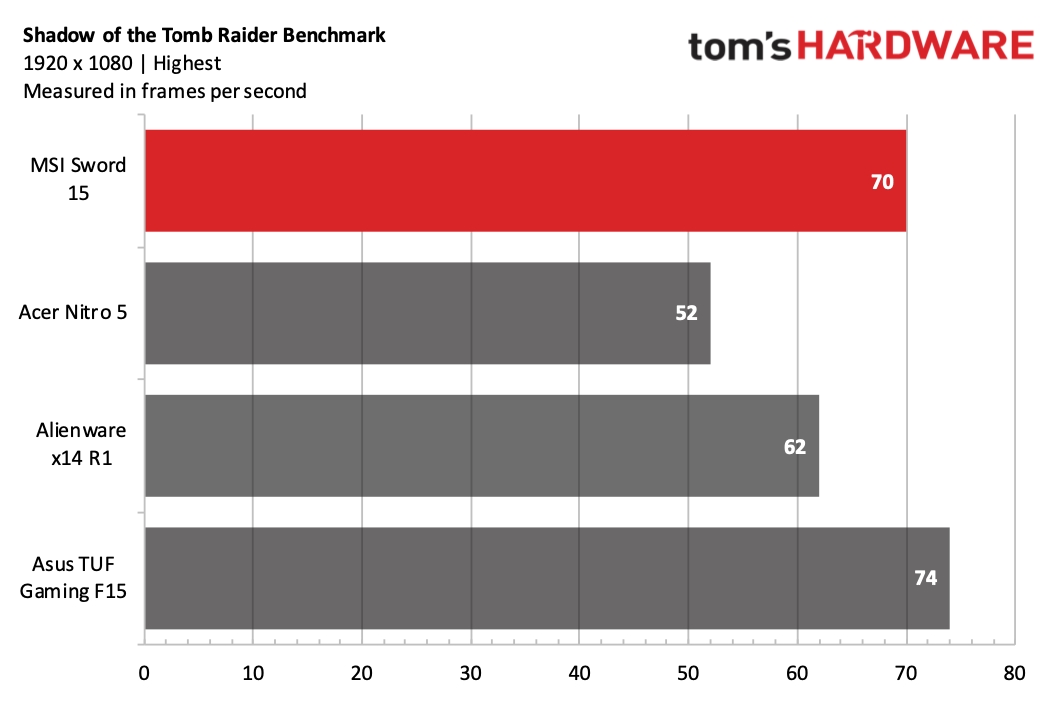
Things took a similar turn with Grand Theft Auto V benchmarking (Very High), as the Sword 15 tied the TUF Gaming F15 at 90 fps. They both left the Nitro 5 and the x14 R1 in the dust.
For a more CPU-dependent test, we switched to Far Cry New Dawn, where the TUF Gaming F15 once again flexed its muscle, outperforming all others with a result of 97 fps. The Sword 15 only managed to take third place this time around with 90 fps, while the x14 R1 split the difference with 94 fps.
Red Dead Redemption 2 punishes graphics cards, necessitating dialing back some of the available graphical goodies. While using the Medium setting at 1080p, the Sword 15 easily galloped past the Nitro 5 and x14 R1 at 57 fps, but still came just shy of the overachieving TUF Gaming F15 (59 fps).
In a turn of events, the Sword 15 won out in the Borderlands 3 benchmark at "badass" settings (69 fps). Again, this result easily eclipsed the Nitro 5 and x14 R1, and even managed to surpass the TUF Gaming F15 (65 fps).
Finally, we put the Sword 15 through our Metro Exodus stress test, with 15 back-to-back runs with the RTX preset. The laptop averaged 56.93 fps during our benchmarking, and the frame rate was quite consistent.
The CPU's performance cores clocked in at 2.51 GHz on average, while the efficiency cores averaged 2.23 GHz. The CPU measured 68 degrees Celsius. The RTX 3060 clocked in with an average speed of 1,360 MHz and a temperature of 64 degrees Celsius.
Productivity Performance on the MSI Sword 15
While we’d all love to game on our laptops 24/7, they should also be capable of pulling double duty as work machines. In that case, this configuration of the Sword 15 comes ready to rumble thanks to its Core i7-12650H (10 cores, 16 threads) processor, 16GB of DDR4-3200 RAM and a generous 1TB NVMe PCIe 4.0 SSD.
Geekbench 5 is a synthetic benchmark primarily tasked with measuring CPU performance. The Sword 15 pulled in a single-core score of 1,760, putting it within striking distance of the TUF Gaming F15 (1,781). In the multi-core benchmark (10,259), the Sword 15 with its Core i7-12650H just couldn't keep up with the Core i7-12700H found in the x14 R1 and TUF Gaming F15 (12 cores, 20 threads).

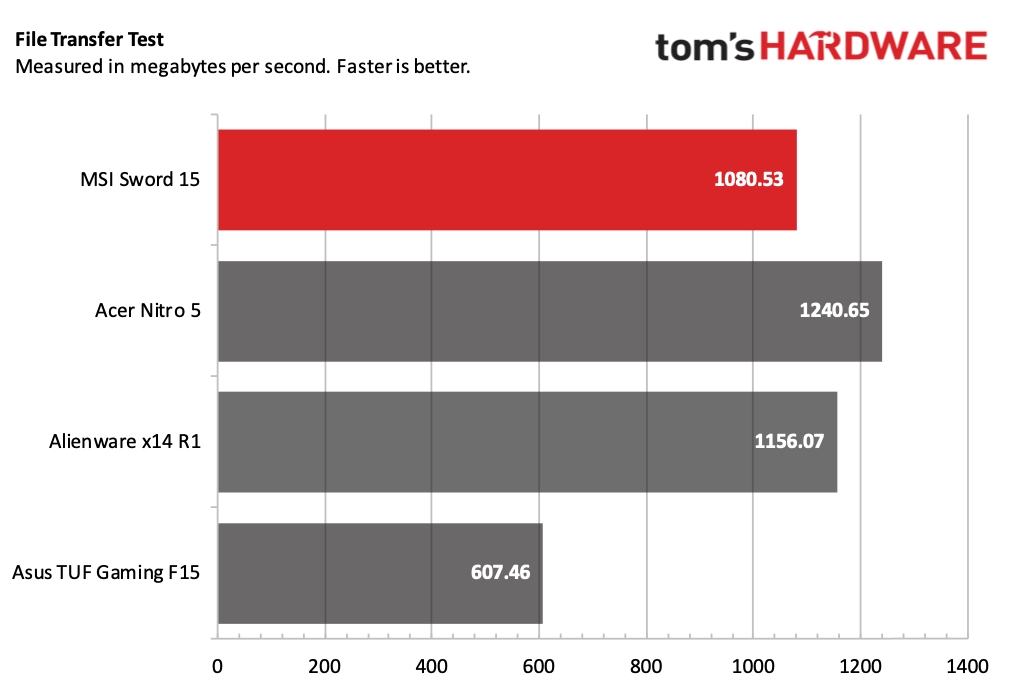
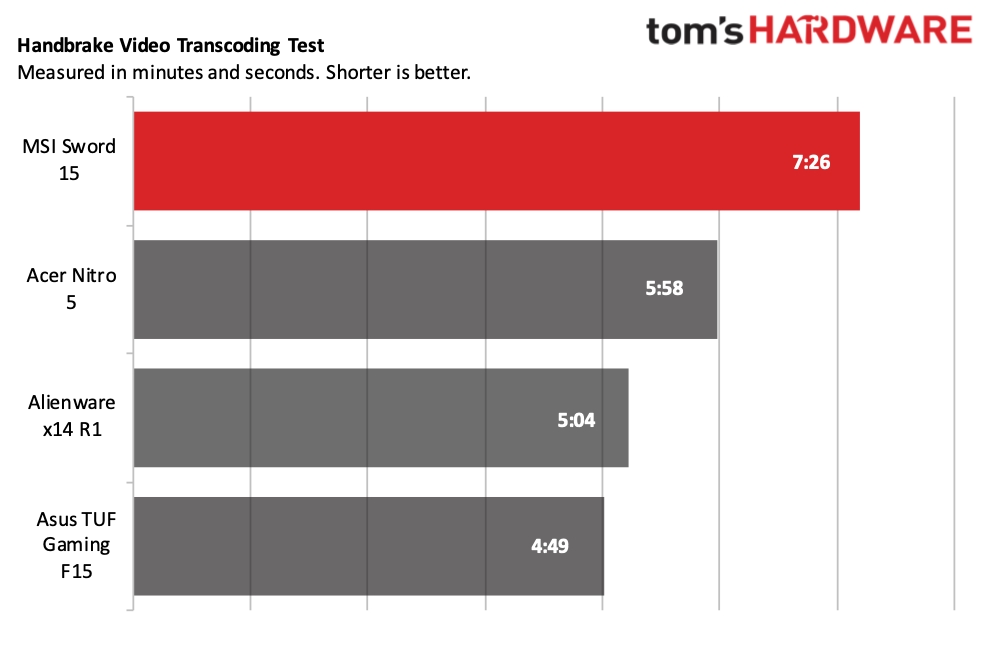
When it came time to shift our attention to our file transfer test, the Sword 15 copied 25GB of data at 1,080.53 MBps, putting it in third place behind the Nitro 5 and x14 R1.
Our final stop in our productivity benchmarking suite comes with Handbrake video transcoding test. In one of the most lopsided results we've seen so far for the Sword 15, it pulled up the rear with a result of 7:26 while converting a 4K video to 1080p. The next-shortest time was the third-place Nitro 5 at 5:58, while the Core i7-12700H-equipped TUF Gaming F15 cruised to a 4:49 first-place finish.
Display on the MSI Sword 15
The Sword 15 uses a 15.6-inch, 1080p IPS display with a matte finish. But the display isn’t particularly bright (247 nits) or vibrant compared to the Nitro 5 (314 nits), TUF Gaming F15 (324 nits) and x14 R1 (377 nits) in our testing.
I watched the seventh episode of "She-Hulk: Attorney at Law" and the fourth episode of "Star Wars: Andor" on the MSI laptop and the colors in both were muted. For example, in most scenes, She-Hulk’s skin skewed more toward a dull, grayish-green than typical Hulk green. The colors didn’t look bad, but we’ve seen better performance from laptop displays in this class.

When it came time to subject the Sword 15 to our colorimeter, it reproduced 45.5% of the DCI-P3 color gamut and 64% of the sRGB color gamut. This was nearly identical performance compared to the Nitro 5. However, the Sword 15 came up short against the x14 R1 and the TUF Gaming F15 in the color tests, and lagged all competitors in brightness, registering a modest 247 nits.
Keyboard and Touchpad on the MSI Sword 15
Like its immediate competitors, the MSI Sword 15 features a full keyboard with a number pad. There are no dedicated keys for oft-used functions like volume or screen brightness; they’re accessible using the Fn key. For example, using the Fn + F8 combo allows you to cycle through the different brightness levels for the backlit keyboard. The keyboard felt a little cramped for my taste, especially around the number pad area.
Using keyhero.com to test my typing speed and accuracy, I notched 98.5 words per minute at a 90.53 percent accuracy using my desktop keyboard. That score fell to 86.43 words per minute and 89.46 percent accuracy with the Sword 15.

The touchpad measures 2.5 x 4.12 inches and is offset to the left of the center on the keyboard deck. MSI had room to make the touchpad taller and wider but didn’t choose to do so.
While testing, I found my left wrist fighting for space while typing since the touchpad is offset so far to the left. This proved to be annoying when accessing the WASD keys while gaming. In comparison, there was a veritable ocean of space for my right wrist while typing and gaming. Thankfully, the touchpad can be turned off by pressing Fn+ F4. And of course, most gamers will use a mouse.
Audio on the MSI Sword 15
The MSI Sword 15’s twin 2-watt speakers are located at the top of the keyboard deck, directly below the display. The speakers don’t sound bad, but the overall vibe I got was “muddy.” When I watched Thor: Love and Thunder on Disney Plus, it sounded like I was listening to the action with my hands cupped over my ears.
Listening to "Dreaming Tree," from Dave Matthews Band’s third studio album, Before These Crowded Streets, was a disappointment. Stefan Lessard’s bass guitar is ever-present throughout this track (when listening on a halfway decent speaker system or headphones), but it was barely perceptible with the Sword 15.
You can adjust audio settings with the included Nahimic and Realtek apps. However, I didn’t find them to make a huge difference in audio quality.
Webcam on the MSI Sword 15
The Sword 15 uses a 720p webcam, which means you’re not getting the best of the best here. The webcam is centrally located above the display and is merely passable in this work-from-home era. Brightness is lackluster, and colors look dull and lifeless with the low resolution. A purple shirt I was wearing looked grey, while the hair on my mustache and beard looked like a blurry bob due to over-aggressive smoothing.
Throw in an overall graininess to the resulting image and a lack of IR for Windows Hello, and we can see that MSI just went for the bare minimum here. As a nice touch, a tiny white LED blinks to let you know when the webcam is active. If making clear calls matters to you, consider getting one of the best external webcams.
Upgradeability of the MSI Sword 15
Getting inside the Sword 15 is straightforward. It only requires the removal of 13 Phillips-head screws and some careful plastic clip pulling (particularly around the exhaust vents at the rear). Once the bottom panel is removed, the SSD, two memory slots and Wi-Fi/Bluetooth combo card are readily accessible.
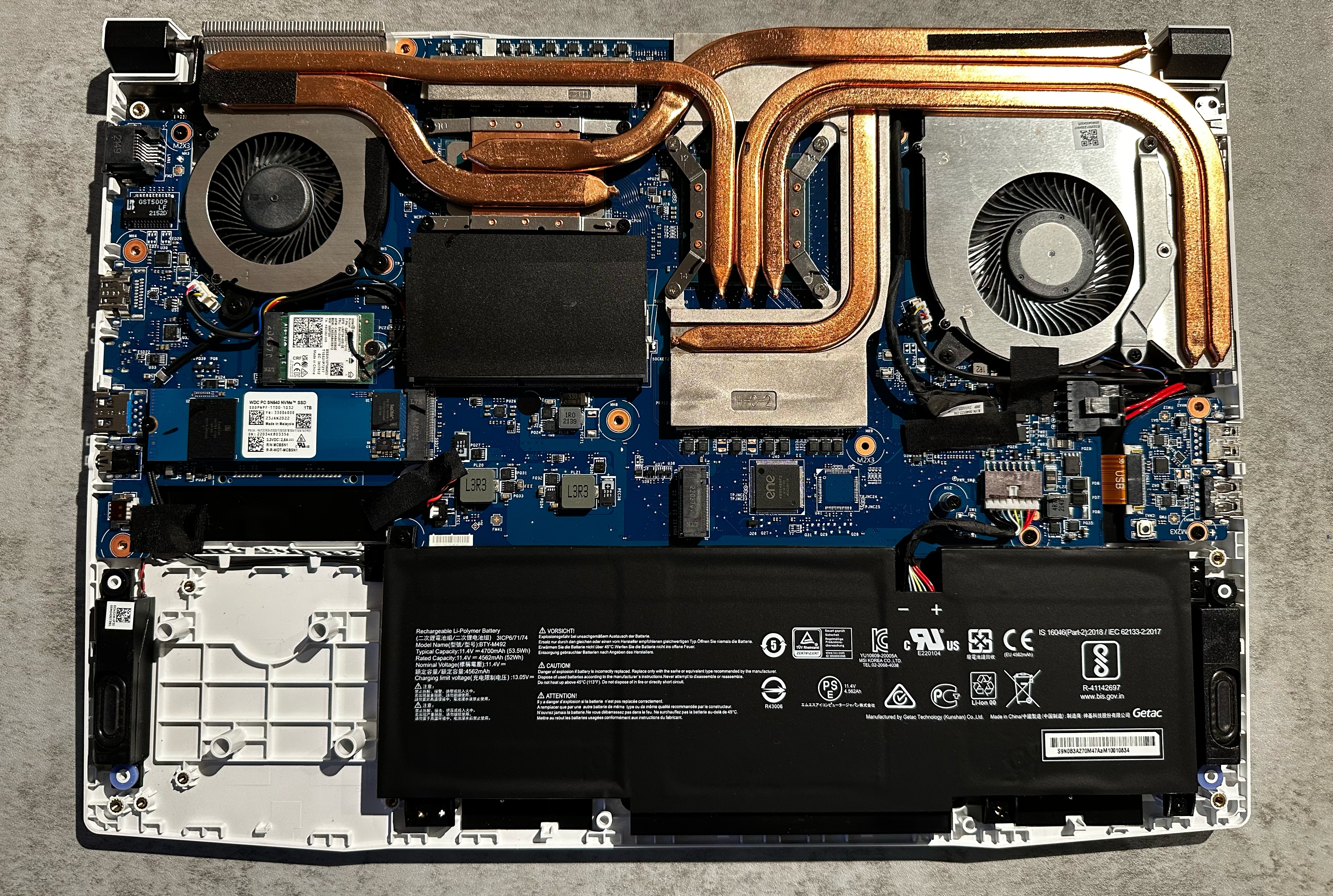
I should also note that it looks like the battery can be swapped out by removing three additional screws and unplugging one connector on the motherboard. There’s even an empty slot to add a second M.2 2280 PCIe SSD if you desire. In our test configuration with 16GB of DDR4-3200, both memory slots were filled.
Battery Life on the MSI Sword 15

We don’t expect too many unplugged hours from a gaming laptop, given the hardware crammed under the hood, and the Sword 15 is no exception. In this gathering of similarly equipped laptops, the Sword 15 pulled up the rear with a runtime of three hours and 55 minutes in our battery test (which includes video streaming, web browsing and graphics work while connected via Wi-Fi).
Testing is performed with the display dialed in at 150 nits. In this comparison group, the TUF Gaming F15 was the overachiever, nearly doubling the MSI’s runtime (7:35).
Heat on the MSI Sword 15
While the Sword 15 was running the Metro Exodus stress test, we measured temperatures around the laptop to see how comfortable (or uncomfortable) it can get during gaming sessions.
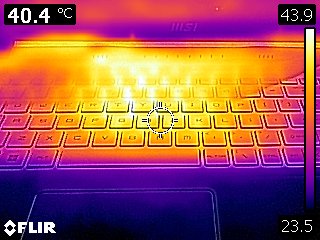
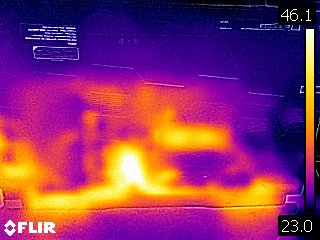
The keyboard measured 40.4 degrees Celsius (104.72 degrees Fahrenheit) between the H and J keys, but I didn’t find the heat to be objectionable while gaming. The bottom of the Sword 15 was definitely hotter, measuring 46.1 degrees (114.98 degrees Fahrenheit) near the heat pipes at the rear end of the laptop.
I should mention that while running the Metro Exodus stress test and gaming in general, the fans quickly spun up to an obnoxiously loud level. This wasn’t a moderate hum but a shrieking noise that could only be drowned out by a pair of noise-canceling earphones.
Software and Warranty on the MSI Sword 15
Our MSI Sword 15 came preinstalled with Windows 11 Home and some useful OEM utilities. There’s the MSI App Player and MSI Center, where you can access the hardware monitor and adjust fan speed profiles.
However, there's also the typical Windows bloatware, including Disney Plus, Spotify, TikTok, and Adobe Express. The latter two are featured as pinned apps in the Start Menu and don’t actually install until you click them.
You’ll also find add-ons like Nahimic and Realtek apps for audio.
MSI sells the Sword 15 with a one-year warranty.
MSI Sword 15 Configurations
The MSI Sword 15 that we received for testing is the A12UE-605 model, which is available from Best Buy for $1,349.99. That price gets you an Intel Core i7-12650H processor, 16GB of DDR4-3200 RAM, Nvidia GeForce RTX 3060 (6GB) GPU, 15.6-inch 1080p 144 Hz display and a 1TB PCIe SSD.
There’s also a cheaper A12UC-295 model available from Best Buy, priced at $949.99. That model subs in a lower-end Core i5-12450H processor, GeForce RTX 3050 (4GB) GPU, 8GB of DDR4-RAM and a 512GB PCIe SSD.
Bottom Line
The MSI Sword 15 comes out of the gate swinging with excellent gaming performance that places it toe-to-toe with the more expensive (and more powerful) competitors. The Asus TUF Gaming F15 is a good alternative if you want to eke out more performance, and it offers nearly four hours of additional runtime on battery power for an additional $150.
However, the Sword 15 held its own in the productivity tests, though it stumbled in Handbrake and pulled up the rear in battery life tests. But given that this is a gaming laptop, the lower battery life results aren’t weighed as heavily here.
The ergonomics could be better (the aforementioned left-skewed touchpad and cramped number pad leave something to be desired) and the fan noise can be annoying while gaming if you’re not using headphones. However, we are fans of the overall design of the Sword 15, its solid build quality, subdued blue keyboard lighting, and relative portability in this class.
If you’re looking for a well-rounded and highly mobile 1080p gaming laptop in the sub $1,400 price range, the MSI Sword 15 should be near the top of your shopping list.

Brandon Hill is a senior editor at Tom's Hardware. He has written about PC and Mac tech since the late 1990s with bylines at AnandTech, DailyTech, and Hot Hardware. When he is not consuming copious amounts of tech news, he can be found enjoying the NC mountains or the beach with his wife and two sons.